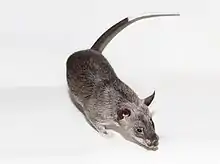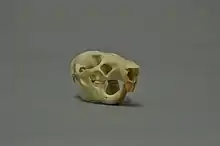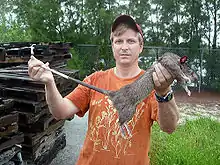Gambian pouched rat
The Gambian pouched rat (Cricetomys gambianus), also known commonly as the African giant pouched rat, is a species of nocturnal pouched rat of the giant pouched rat genus Cricetomys, in the family Nesomyidae. The species is among the largest muroids in the world, growing up to about 0.9 metres (3 ft) long including the tail which makes up half of its total length.[2] It is widespread in Sub-Saharan Africa, ranging geographically from Senegal to Kenya and from Angola to Mozambique (although it is absent from much of the DR Congo, where Emin's pouched rat is present) and in altitude from sea level to 2,000 metres (6,600 ft).[1]
| Gambian pouched rat | |
|---|---|
 | |
| Cricetomys gambianus as a captive pet | |
| Scientific classification | |
| Kingdom: | Animalia |
| Phylum: | Chordata |
| Class: | Mammalia |
| Order: | Rodentia |
| Family: | Nesomyidae |
| Genus: | Cricetomys |
| Species: | C. gambianus |
| Binomial name | |
| Cricetomys gambianus Waterhouse, 1840 | |
The Gambian pouched rat is sometimes kept as pet, but some have escaped from captivity and become an invasive species in Florida.[3] The CDC and FDA in the US now ban the importation of this species because it is blamed for the 2003 outbreak of monkeypox.
Characteristics

The Gambian pouched rat has very poor eyesight and so depends on its senses of smell and hearing.[4] Its name comes from the large, hamster-like pouches in its cheeks. It is not a true rat but is part of an African branch of muroid rodents. It typically weighs between 1 and 1.4 kilograms (2.2 and 3.1 lb).[2] In its native Africa, the pouched rat lives in colonies of up to twenty, usually in forests and thickets, but also commonly in termite mounds. It is omnivorous, feeding on vegetables, insects, crabs, snails and other items, but apparently preferring palm fruits and palm kernels.
Unlike domestic rats, it has cheek pouches like a hamster. These cheek pouches allow it to gather up several kilograms of nuts per night for storage underground. It has been known to stuff its pouches so full of date palm nuts so as to be hardly able to squeeze through the entrance of its burrow. The burrow consists of a long passage with side alleys and several chambers, one for sleeping and the others for storage. The Gambian pouched rat reaches sexual maturity at 5–7 months of age. It has up to four litters every nine months, with up to six offspring in each litter. Males are territorial and tend to be aggressive when they encounter one another.
Laboratory use
The Gambian Pouched rat is currently being used in psychology experiments at Cornell University in the USA to investigate its usefulness in the detection of tuberculosis in human sputum samples.[5]
Invasive species

Gambian pouched rats have become an invasive species on Grassy Key in the Florida Keys,[6] after a private breeder allowed the animals to escape.[7] This outsized African rodent is also believed to be responsible for the 2003 outbreak of monkeypox in the United States, after spreading it to prairie dogs which were purchased as pets. In 2003, the United States' CDC and FDA issued an order preventing the importation of the rodents following the first reported outbreak of monkeypox. Around 20 individuals were affected.[8]
Ability to detect land mines and tuberculosis by scent
A Tanzanian social enterprise founded by two Belgians, APOPO, trains Gambian pouched rats to detect land mines and tuberculosis with their highly developed sense of smell. The trained pouched rats are called HeroRATS. The rats are far cheaper to train than mine-detecting dogs; a rat requires $7,300 for nine months of training, whereas a dog costs about $25,000 for training.
In 2020 a Hero Rat received a PDSA Gold Medal, the animal equivalent of the George Cross, becoming the first rat to receive the award since the charity began honouring animals 77 years ago. 'Magawa' has detected 39 landmines and 28 items of unexploded ordnance, clearing over 1,517,712 square feet [141,000 square metres.] of land, preventing many injuries and deaths, in his 4 year career so far. [9][10]
See also
References
- van der Straeten, E.; Kerbis Peterhans, J.; Howell, K. & Oguge, N. (2008). "Cricetomys gambianus". IUCN Red List of Threatened Species. 2008. Retrieved 11 July 2009.CS1 maint: ref=harv (link)
- Kingdon, J. (1997). The Kingdon Field Guide to African Mammals. p. 199-200. ISBN 0-12-408355-2
- "Keeping and Caring for Gambian Pouched Rats as Pets". The Spruce Pets. Retrieved 2021-01-28.
- Olude, M. A.; Ogunbunmi, T. K.; Olopade, J. O.; Ihunwo, A. O. (2014). "The olfactory bulb structure of African giant rat (Cricetomys gambianus, Waterhouse 1840) I: Cytoarchitecture". Anatomical Science International. 89 (4): 224–231. doi:10.1007/s12565-014-0227-0. PMID 24469950.
- "Pouched rats sniff for land mines and medical samples". Radio National The Science Show. Australian Broadcasting Corporation. May 18, 2019. Retrieved May 22, 2019.
- "More huge Gambian rats found on Grassy Key", keysnet.com, March 25, 2012, archived from the original on 2012-03-28
- Florida tries to wipe out cat-sized African rats, Reuters, 2007
- Conlon, Michael (2008-10-06). "Kids want an exotic pet? Ask your doctor first". Reuters. Retrieved 2008-10-06.
- "Meet the gold medal-winning rodent". BBC News. Retrieved 2021-01-28.
- Ng, Kate (September 25, 2020). "Cambodia landmine detection rat awarded miniature gold medal for 'lifesaving bravery'". The Independent. Archived from the original on November 26, 2020.
- Novak, R.M. and Paradiso, J.L.; Walkers Mammals of the World, Vol II. Johns Hopkins University Press, Baltimore, 1991.
- Perry, N. D., et al. 2006. "New invasive species in southern Florida: Gambian rat (Cricetomys gambianus)". Journal of Mammalogy, 87:262-264.
- Peterson, A. T., et al. 2006. "Native range ecology and invasive potential of Cricetomys in North America". Journal of Mammalogy, 87:427-432.
- - a story from National Geographic News regarding the use of giant pouched rats and bees to detect land mines in Africa
External links
| Wikimedia Commons has media related to Cricetomys gambianus. |
